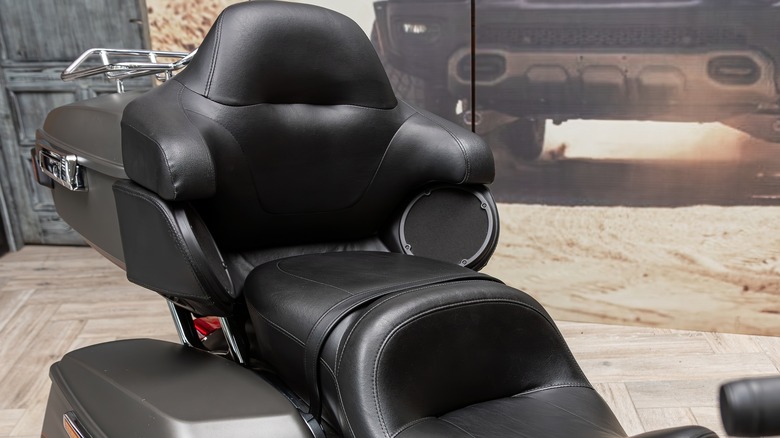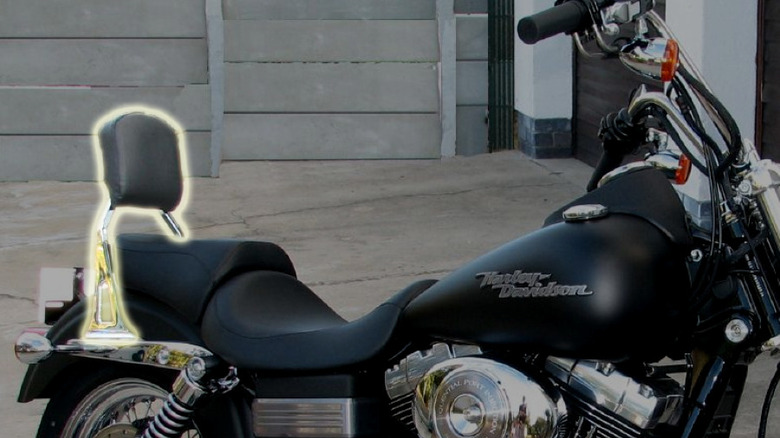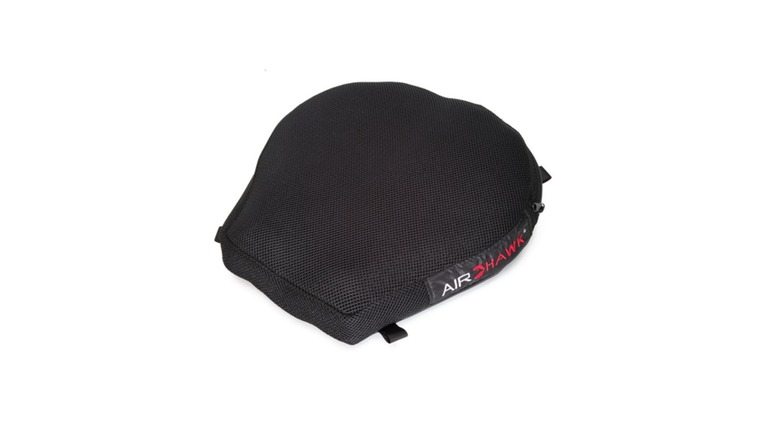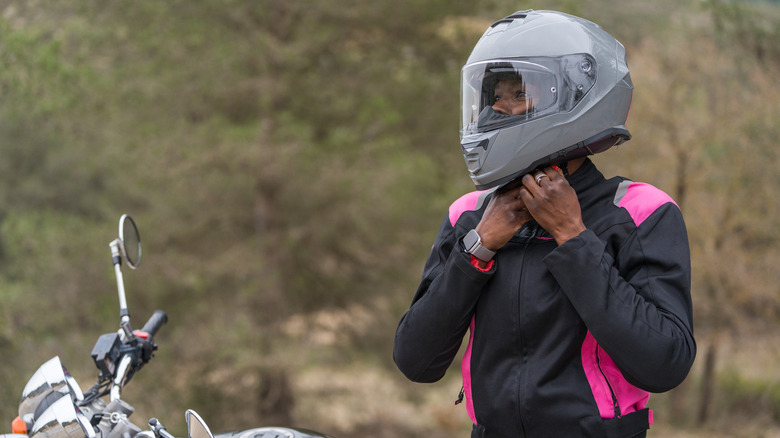6 Of The Best Harley-Davidson Upgrades For Passenger Comfort
The motorcycle experience often focuses on the person gripping the handlebars, emphasizing the rider triangle, lean angles, braking, lap times, and horsepower. But riding doesn't have to be (and usually isn't) about screaming around a track. Sharing a ride with a loved one is a great way to spend some bonding time — unless your Harley is uncomfortable.
There are two nice things about Harley-Davidson motorcycles. First, they enjoy one of the world's largest selections of aftermarket add-ons, so finding Harley-Davidson accessories to improve comfort should be a cinch. The second thing is that Harley-Davidsons are not generally that uncomfortable.
Some motorcycles leave a bare patch of hard plastic set at an impossible angle for their passengers, and some supersport bikes do away with having a second seat entirely — not so for Harley-Davidson. Plush seating and relaxed angles help make it more about experiencing the ride and less about shaving a lap time.
However, not every Harley-Davidson comes equipped for long-term passenger comfort. If you are a rider who wants to improve the experience for a loved one or a frequent passenger, check out some of these great upgrades.
Seat swap
Seating is a rider's first stop when upgrading for passenger comfort. The rider is in control of the motorcycle and can anticipate movements, including sudden movements away from obstacles and bracing for that unseen speed bump or pothole. Having a secure relationship with a comfortable seat contributes not only to passenger enjoyment but also to overall safety.
Fortunately, several quality companies, such as Corbin, LaPera, Mustang, and even the mother company, Harley-Davidson, build comfortable Harley-Davidson motorcycle seats that riders swear by.
On a bike like a Harley-Davidson, the seat contributes as much to the aesthetic line as the frame or the gas tank. Some riders choose a seat that is easy to swap. When their partner wants to ride, a simple switch gives them access to a thicker seating pad, something to lean against, cup holders, or even just a better position to hold their thighs.
It is impossible to recommend any one seat due to Harley's wide selection of motorcycles and riders' varying needs. Mustang motorcycle seats are popular among enthusiasts, as are Harley's own aftermarket offerings.
The most significant limiting factor in buying a new seat is finding one that matches your needs. Sometimes a little sissy bar is enough, but serious cruisers might call for the complete armchair treatment. Finding one that fits on the motorcycle is the next priority. Seats need to fit precisely. Harley has made hundreds of models over the years, and seats have a very close relationship with the frame they sit on.
Foot pegs
The seat is not the only part of the motorcycle on which the body rests. Footpegs dictate a lot about the passenger's experience. Everyone's legs differ in length, but even if the pegs are set to the correct height, they can transmit a lot of vibration through the feet and into the body. They also dictate how the passenger's legs are oriented around the rider's body. Can the passenger move without upsetting the ride? Any position is torturous after a long enough time.
Investing in the right highway footpegs for your Harley-Davidson can significantly improve your riding experience. Footpegs endure a lot of wear and tear on the road, so it's crucial to look for ones made of durable materials. Steel, titanium, and aluminum are popular choices, ensuring longevity and safety.
When it comes to long trips, comfort is key. Resting your foot in a single spot for an extended period requires some forethought. While a simple peg usually comes with a rubber coating, footboards are a popular choice for long journeys. Footboards allow a passenger to lay their foot flat (or in whatever position is comfortable) rather than be confined to a peg's limited range of motion, ensuring a more comfortable ride.
Riders can also benefit. In addition to having your passenger along for the adventure, the placement of their (and your own) feet can make or break the trip. Seek out a pair of "highway" pegs to stretch your legs on long trips.
Back rest/sissy bar
If a complete seat switch isn't in order, adding a sissy bar can make a world of difference. Sissy bars are back supports for the passenger. The rider has the luxury of the handlebars to brace against and control the motorcycle, but a quick maneuver can be a startling proposition for a passenger without much to hold on to. A sissy bar give passengers something to brace against, and prevent any sensations of sliding off the back of the bike. They are relatively low-tech, low-effort installations, but significantly impact passengers' riding experience.
Sissy bars come in a lot of different sizes, everything from 6 inches to several feet. Harley makes a plethora of its own, but so does every aftermarket manufacturer in the world. It is a staple of motorcycle equipment because it is inexpensive, simple, and effective.
If the owner of the motorcycle doesn't want to change the profile of the bike, a detachable or low-key sissy bar may be in order. However, the right one could accentuate the bike's features while providing the passenger with a lot of utility and comfort.
[Featured image by Danie van der Merwe via Wikimedia Commons | Cropped and scaled | CC BY-SA 2.0]
Seat cushion
What the sissy bar does the for back, the seat cushion does for the tush. If a full seat isn't in the budget, combining the two could be a cheaper way to buy some comfort! Seat cushions work just like they sound — they add a little extra padding, and some can introduce wider or longer dimensions not available on the original motorcycle.
What you choose for a suit cushion depends enormously on the type of riding you will be doing. Hitting the twisties might call for a polyurethane seat to keep the rider in the saddle. Enduro or trail riding might call for neoprene. Good ol' fashioned leather is durable and comfortable for longer rides.
A seat cushion is not the same as a seat. They tend to be detachable and portable. You could even take it off the bike and use it on a picnic. Getting one made from a substantial durable material is essential, but don't forget there is a decent chance you will carry it around at some point.
Bluetooth audio
Sharing time on a motorcycle can be physically intimate — often the passenger has to wrap their arms around the rider — but something is often missing. With all of the beautiful scenery passing by, it would be pleasant to communicate. Shouting into someone's ear about how you just saw a dear takes some of the pastoral romanticism out of a country ride.
Consider getting one of the best Bluetooth headset devices for your motorcycle helmet. Most will fit seamlessly into your existing helmet or headgear, offering clear communications between rider and passenger. Not only can you share moments about your ride, but it can also prove helpful sharing directions and safety information, and making plans about where to stop for lunch.
Harley-Davidson offers its own Bluetooth headsets, but this is an arena full of aftermarket choices. With advances in wireless technology and the quality of small speakers, talking on a motorcycle should be no problem.
Though some specialty helmets come equipped with Bluetooth, it is not necessary to purchase one to attain this ability. Most Bluetooth systems offer a receiver and smartphone connectivity, giving owners access to GPS and other apps while riding. Many riders use motorcycles to get away from the phone. Speakers fit into the existing helmet cups, making it easy to hear the other speaker, though engine and wind noise may occasionally interfere.
Motorcycling with your partner doesn't have kill the conversation. Enjoy it together!
Weather gear
Let's face it: The worst enemy of the motorcyclist (after pavement) is the weather. Wind and rain can harsh a ride's buzz when there is still a long way to go. Having the proper gear to keep your passenger warm, dry, and happy should be every rider's first priority (after keeping away from that pesky pavement).
Popular motorcycle jackets for under $500 can cover 90% of your needs, but motorcycling is kind of about those extremes. It can be bitterly cold and intensely hot. Finding a jacket or body suit that can always accommodate both is impossible.
The traditional cycling gear has always been leather, but now miracles in material technology make blends of plastics, rubbers, kevlar, and other textiles that keep the rain and road out while letting breathable air in.
The first and best option is to get a proper, waterproof, all-weather jacket. A good helmet, gloves, and footwear complement the essential riding complement. Some may choose to do without, but it is to their peril should the worst happen. Proper weather gear keeps riders safe and happy while upright.






